Club León are a side steeped in history in Mexico. Their eight league titles are the fifth-most in the Liga MX with only Club América, Guadalajara, Toluca and Cruz Azul boasting more.
However, León were also the first side in Mexico to win both the Apertura and the Clausura back-to-back on two separate occasions, once in 1948 and 1949 and again in 2013 and 2014. The last time León lifted a championship crown was back in 2020 when they beat UNAM in the final under the guidance of Atlético Madrid’s former assistant manager Ignacio Ambríz.
Unfortunately, the wait for another championship will go on, though, as Los Panzas Verdes bowed out of the Clausura this past week following a 3-1 home defeat to Atlético de San Luis.
However, the season isn’t over just yet for Nicolás Larcamón’s men. After defeating fellow Mexican side Tigres over two legs in the semi-finals, León have progressed to the final of the CONCACAF Champions League where they will meet the current holders LAFC from MLS.
León reached the CCL final just once prior in history, although the competition’s format was quite different. Sadly, despite finishing level on points with Deportivo Saprissa, the Costa Rican club had a higher goal difference and so claimed the crown. 30 years on, these León have a chance to seek redemption for those who paved the way before them.
Under the guidance of the exciting 38-year-old tactician Larcamón, anything is possible.
In this tactical analysis piece, we will analyse the Mexican giant’s tactics under the Argentine head coach which could see the club earn continental glory for the first time ever.
Going long from goal-kicks
It’s quite rare nowadays to see a team be so successful without playing out from the back. Building up on the deck from goal-kicks has been commonplace with a lot of top sides in the modern game, from Manchester City to Real Madrid. León go against the grain in this respect.
Now, we’re not saying that Larcamón is a younger Big Sam, emphasising percentages and winning second balls in higher areas of the pitch to prevent the risk of losing it closer to their own goal. However, León do take quite a cautious approach from goal-kicks and when they have the ball in their own third.
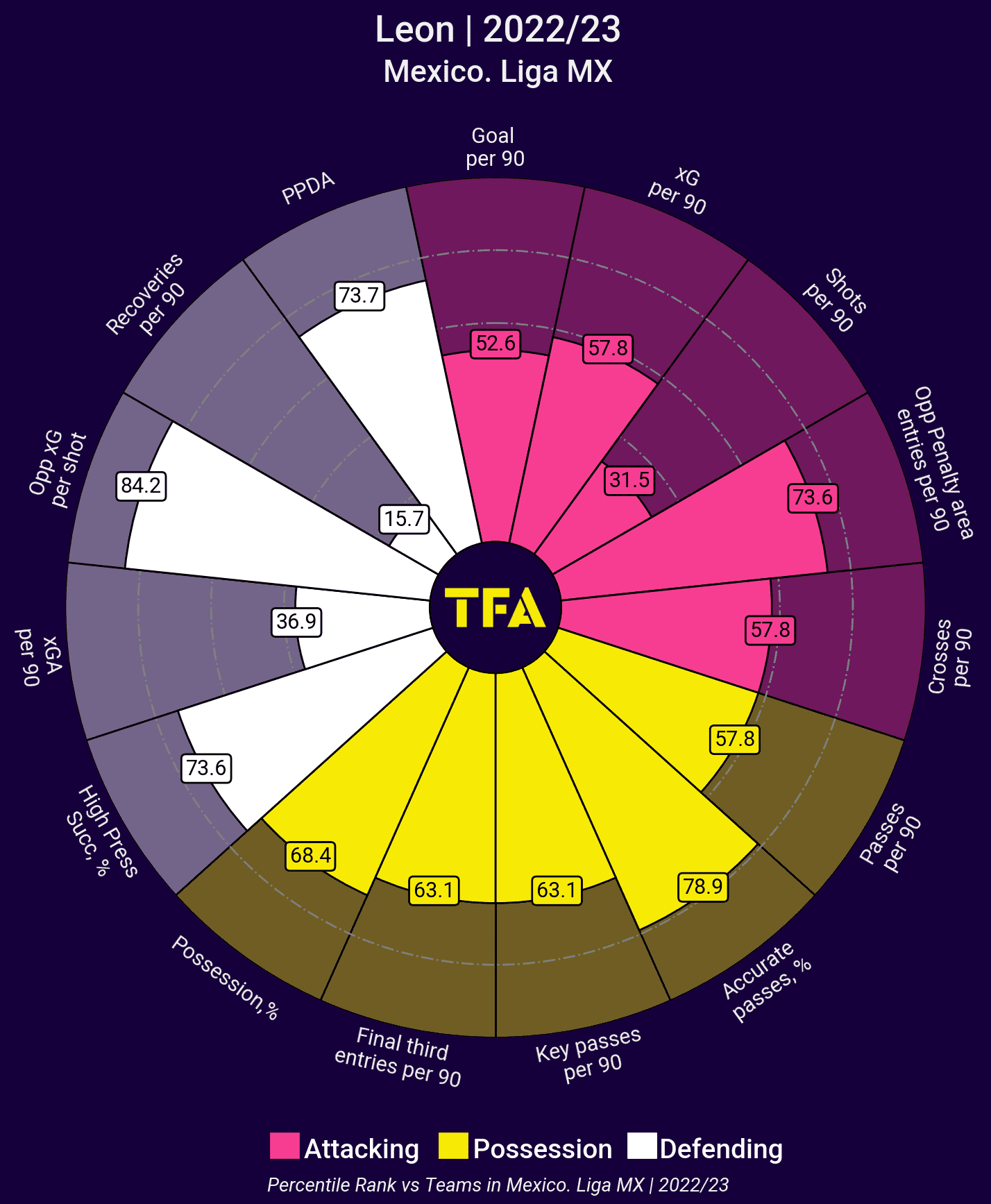
It would be incorrect to label the Champions League finalists as a possession-based side. León have averaged 52.6 percent of the ball per game under their vibrant head coach, attempting 392 passes per match. 11 percent of these passes are long balls.
Through an analysis of the pizza chart provided, León’s style of play is quite telling. The Mexican team rank above the league median for possession, final third entries per 90, key passes per 90 and passes per 90 but this is to be expected given that León are one of the best sides in the country. Nevertheless, their ranking in these metrics doesn’t scream ‘possession-based’, because they aren’t.
It’s also important to make note of León’s choice of formation this season before dissecting their principles on the ball. For the most part, Larcamón has deployed a 4-2-3-1 or a 4-4-2 but at times has switched it up, going with a 3-4-3.
The best instance of this was during the club’s recent trilogy with Tigres. In both CONCACAF CL semi-final legs, the manager sent his players out in a 4-2-3-1 but changed to a 3-4-3 for the Liga MX game in between. Using the 4-2-3-1, León lost the first leg but won the league outing with the 3-4-3. It was a bold call to revert to the 4-2-3-1 for the second leg but one that worked wonders as La Fiera overturned the 2-1 deficit to win 4-3 on aggregate, advancing to the final.
It is also common for Larcamón to switch the shape in-game, particularly from a back four to a back three when winning to add an extra man at the back for defensive stability.
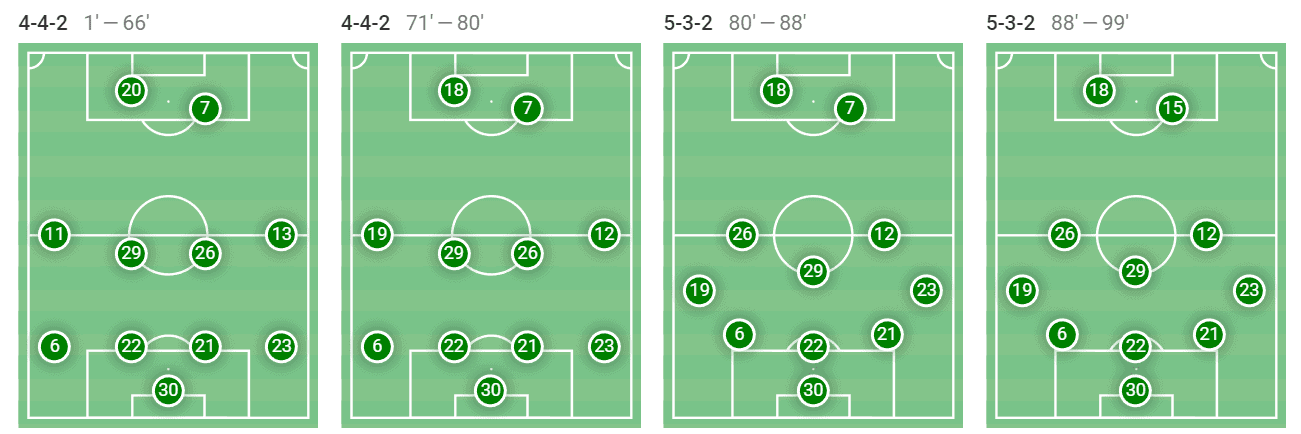
This visual was taken from the team’s 3-1 win over Tigres in the second leg. León were winning 3-1 after a 79th-minute goal from centre-back Adonis Frías. Larcamón quickly changed the formation a minute later, opting to deploy a 5-3-2 to see out the game, which worked.
When playing in a 4-2-3-1, León build out from deep in a 4-2 shape. The fullbacks stay relatively low to attract the opposition’s wingers while the double-pivot come deep, forcing the opposition’s midfield to go man-for-man against them.
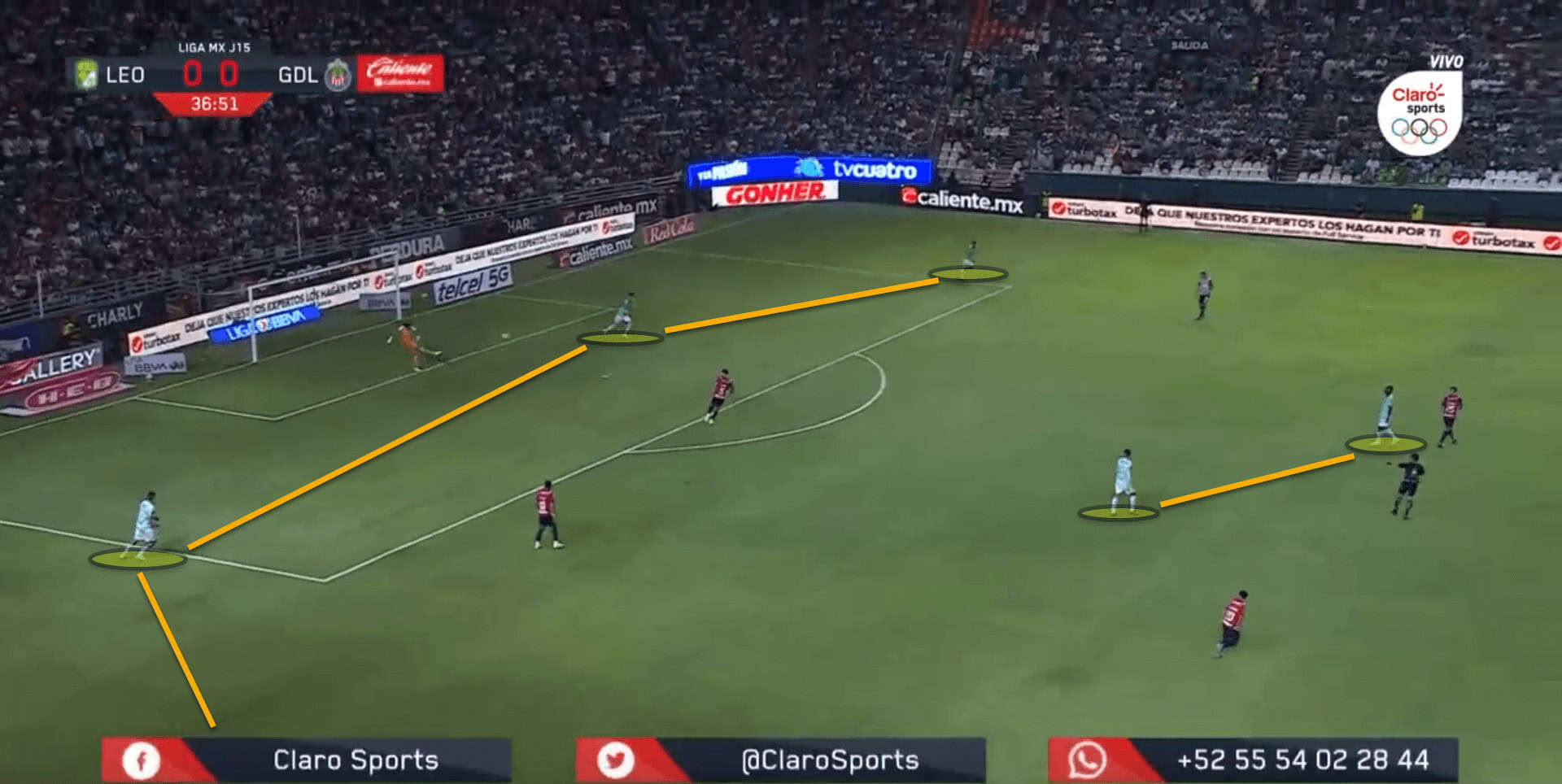
The double-pivot can look to get on the ball in the first third but it’s not a necessity and certainly isn’t that common.
The main idea in this phase is to attract as many of their opponent’s players into higher areas as possible, leaving the backline unprotected.
León always have four players on the last line that are ready for the long ball. For instance, if an opponent are defending in a 4-4-2 shape and go man-for-man against León’s 4-2 build-up structure, Larcamón will have a four versus four against the defence, using their two wingers, centre-forward and number ‘10’ to attack the long ball.
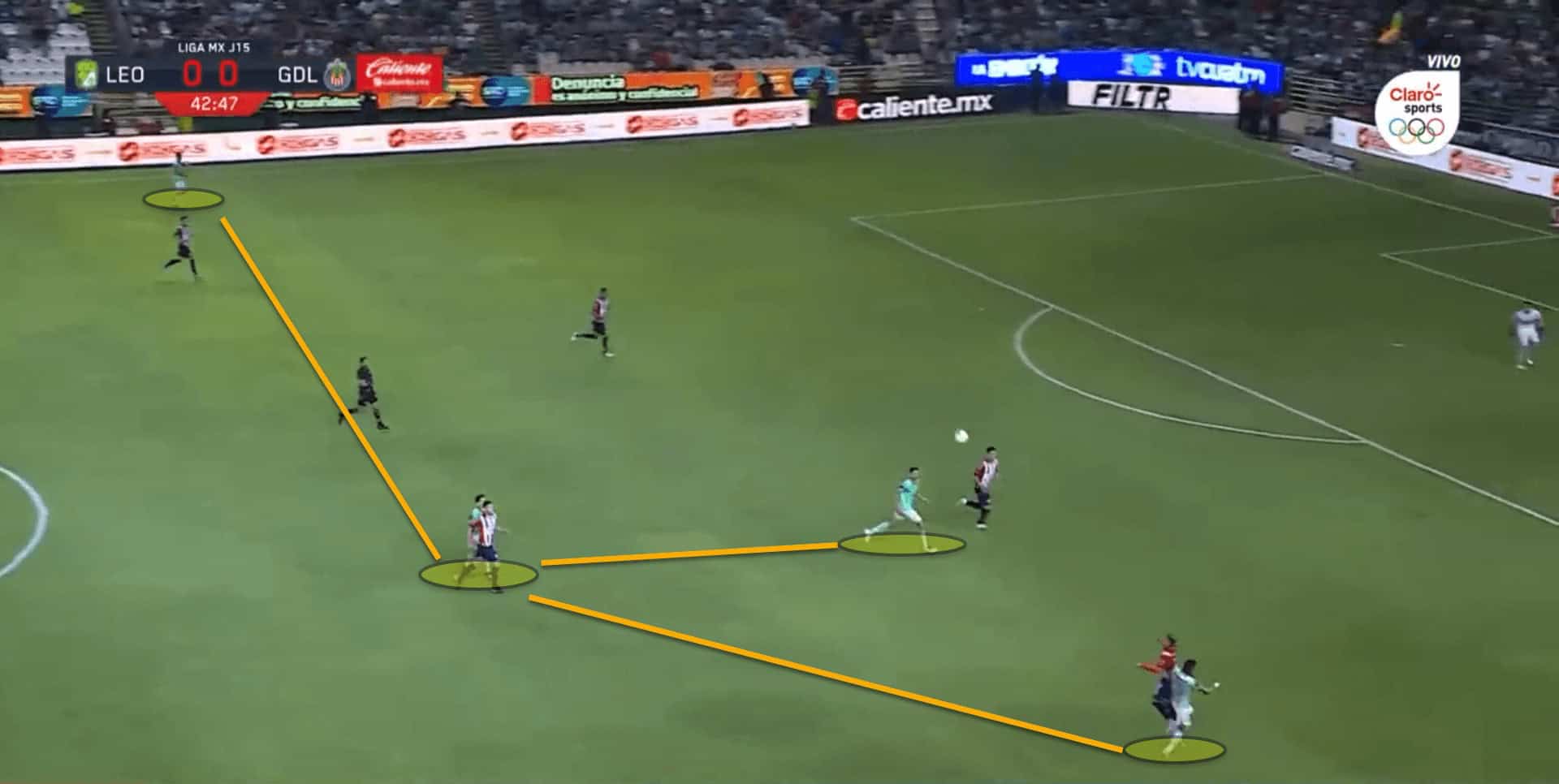
Some teams are a little more cautious when pressing León. For instance, Guadalajara were pressing with five players against León’s back four, double-pivot and goalkeeper in the last two screenshots. The wingers would tuck inside along with one central midfielder while the other pivot player would drop off and protect the backline from long balls. In this case, they would commit five and hold five back, offering a nice balance. This made things a little trickier for León as they would have an inferiority of 5v4 in this area.
But thankfully, León’s double-pivot work really hard once the ball has gone overhead to get up the pitch and support the second ball from behind.
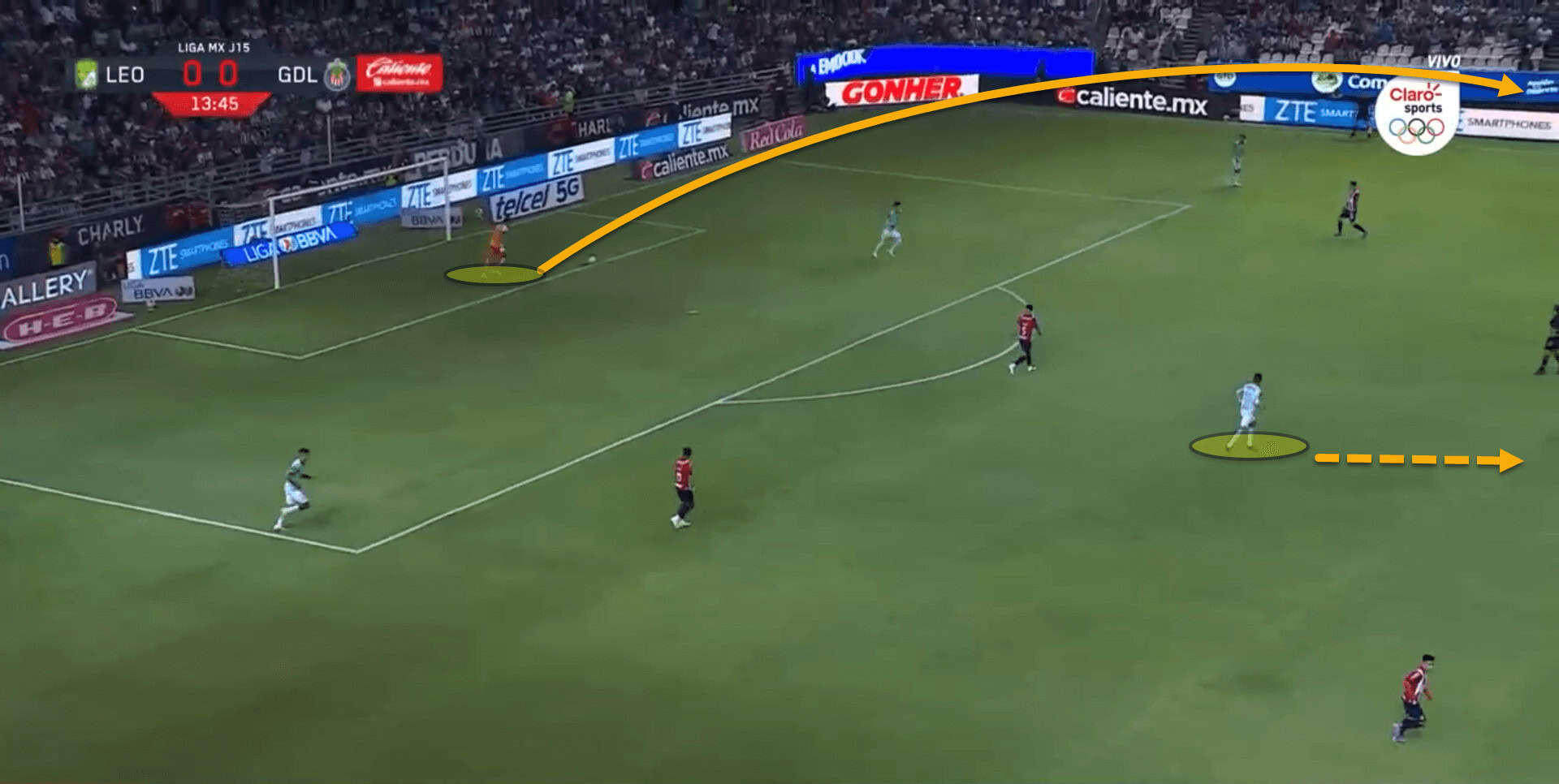
In this example, the ball is with the goalkeeper in the box. León’s left-sided pivot Fidel Ambríz already knows where the next pass is going, and his body orientation is very telling too. He has already started to shift upwards to squeeze the pitch.
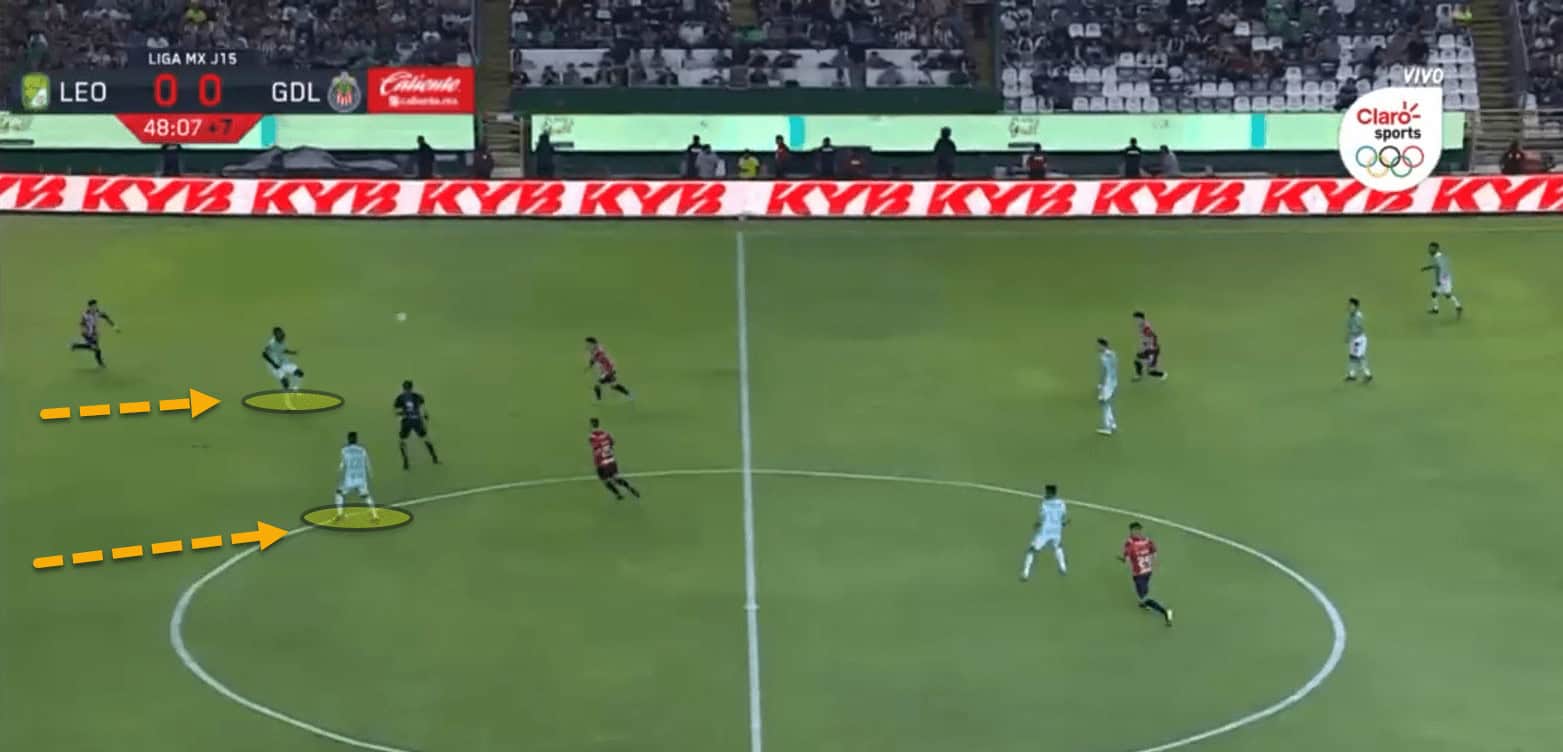
In the next screenshot, Ambríz and his midfield partner, the former Arsenal man Joel Campbell, have provided excellent support to the long pass and were able to win the second ball, sustaining possession in a higher area, avoiding the risk of losing it while passing out from the back.
Vital to León’s ability to play over the press has been the experienced goalkeeper Rodolfo Cota who has a superb long kick on him which allows most of his goal-kicks to reach the opposition’s half.
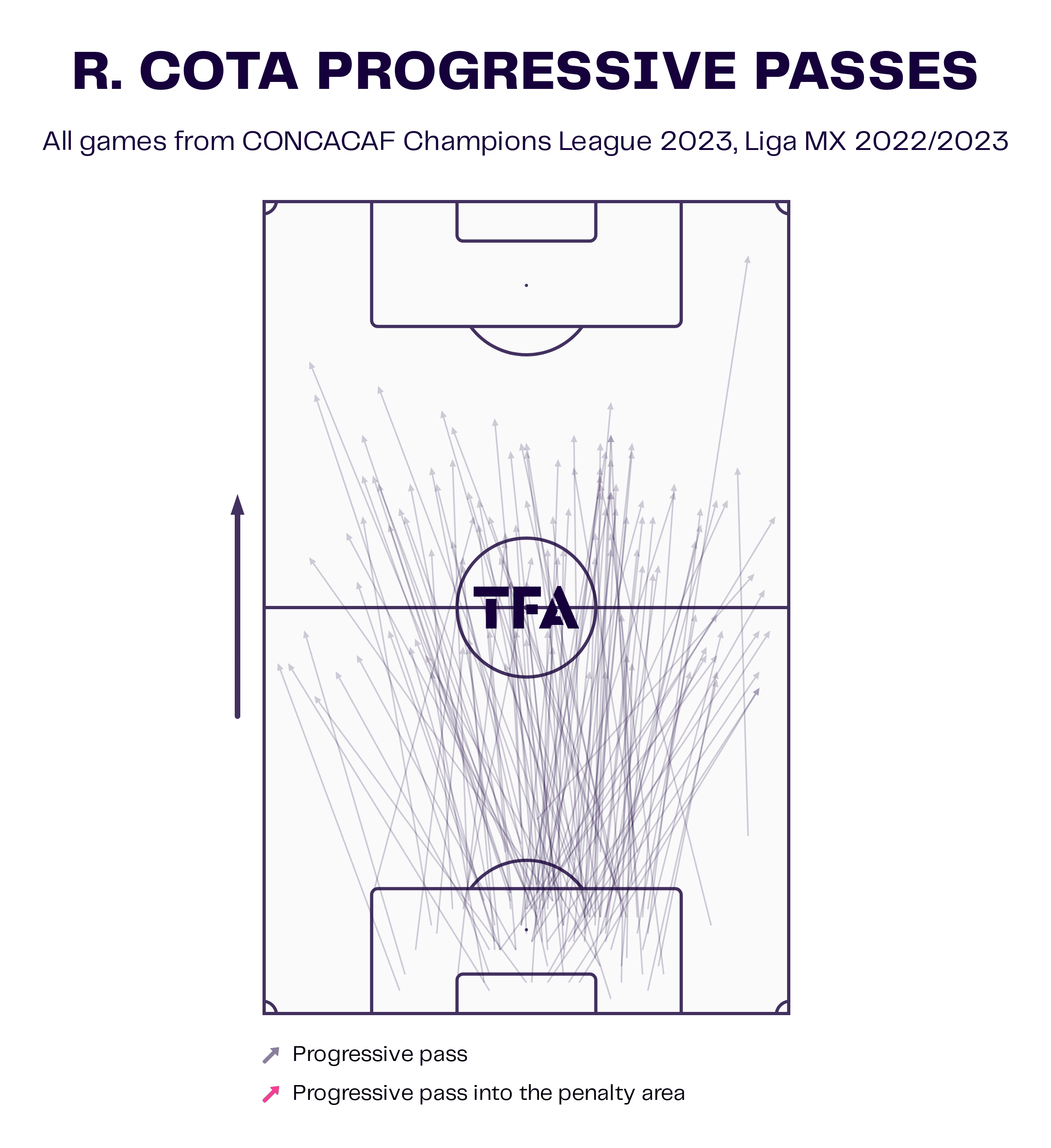
So many of Cota’s progressive passes are long balls which can go inexplicably far at times.
51 percent of Cota’s goal-kicks this season at León have been long while the Mexico international has managed a 72.6 percent accuracy on long passes too. The 35-year-old is also averaging 1.03 passes to the final third per game as well under Larcamón.
Nonetheless, it should be clarified once more that León are far from a long ball team or even a direct side but there is a methodical emphasis from the coach to play over the press rather than through it, similar to Patrick Vieira’s approach to build-up play during his time with Crystal Palace when the Eagles were pressed high.
Creating chances
León boasted the best defensive record in the Clausura which was an impressive record. However, the club finished merely in sixth place. The biggest issue for the Mexican side came in the form of scoring goals. Just eight of the league’s 18 teams scored fewer goals than León over the course of the 2023 league campaign who bagged 23 across the 17 Clausura matches.
23 goals certainly isn’t horrendous but averages out at around 1.35 goals per game, whereas Club América and Monterrey registered 2.12 and 2.06 goals per matches, respectively, and finished higher in the table despite having worse defensive records.
But before we break down León’s expected goals compared to real goals, it’s important to look at how the side create chances.
Larcamón instructs his players to attack down the flanks when León have possession in the progression phase, also known as the second phase or when they have the ball in the middle third of the pitch and are attempting to break down a deep block.
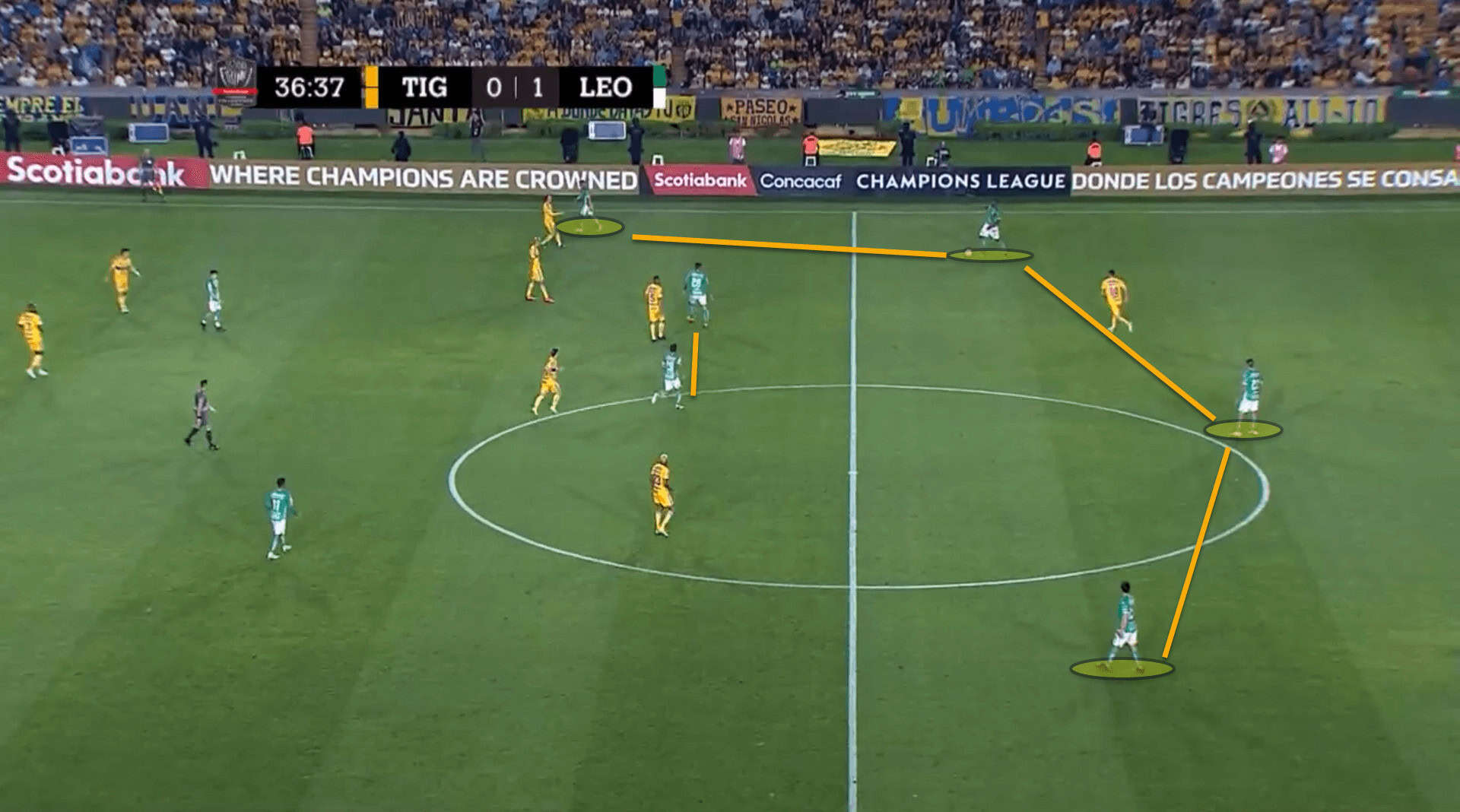
To do so, one of the fullbacks tuck inside, typically the left-back, creating a back three as the opposition usually defend with a front two and so León can create a 3v2 situation, although even if there is just one forward, the three remain intact because one can become two at any point if a midfielder steps up.
It is the right back who is given license to bomb forward on the right flank as the rest of the defenders shift across to cover for their advancing teammate.
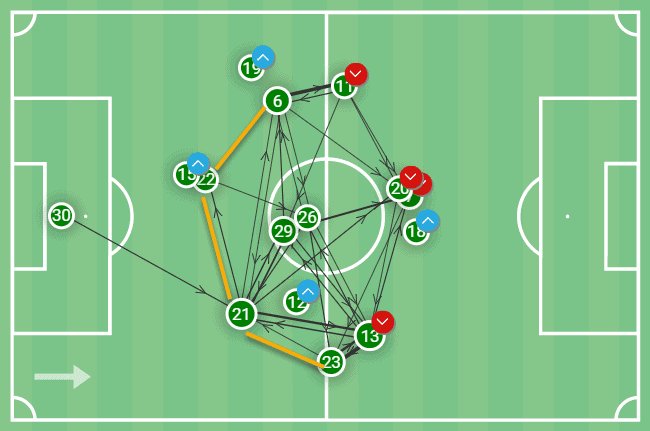
This is evident from an average León pass map too. The left-back (6) is positioned more as a left centre-back while the right-back (23) is further forward on the opposite flank. You’d be mistaken for believing León’s shape was a 3-4-3 but it is indeed a 4-2-3-1.
Another important point to note on the previous passing network is how dense the links were down the sides. This is because León primarily play down the sides and look to get into crossing positions as opposed to playing through the opposition to create chances in the central lanes.
Wide rotations are commonplace in this team, particularly down the right which is the side’s strongest flank and where the greatest attacking threat is.
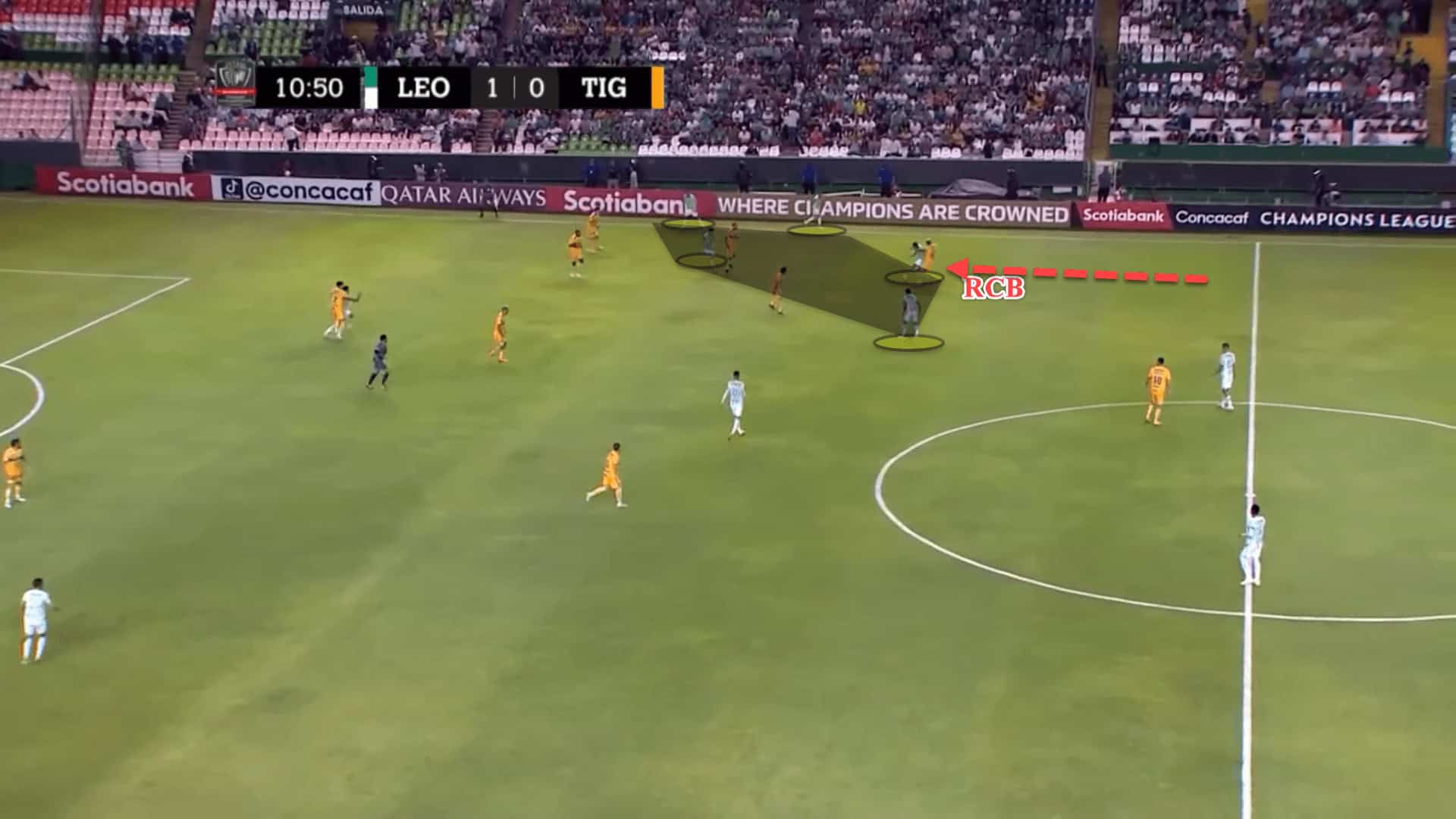
Quite often, we’ll even see the right centre-back step forward to join an overload with the right-back, right winger, number ‘10’ and nearest central midfielder. Of course, these five are not fixed and may be different depending on the situation.
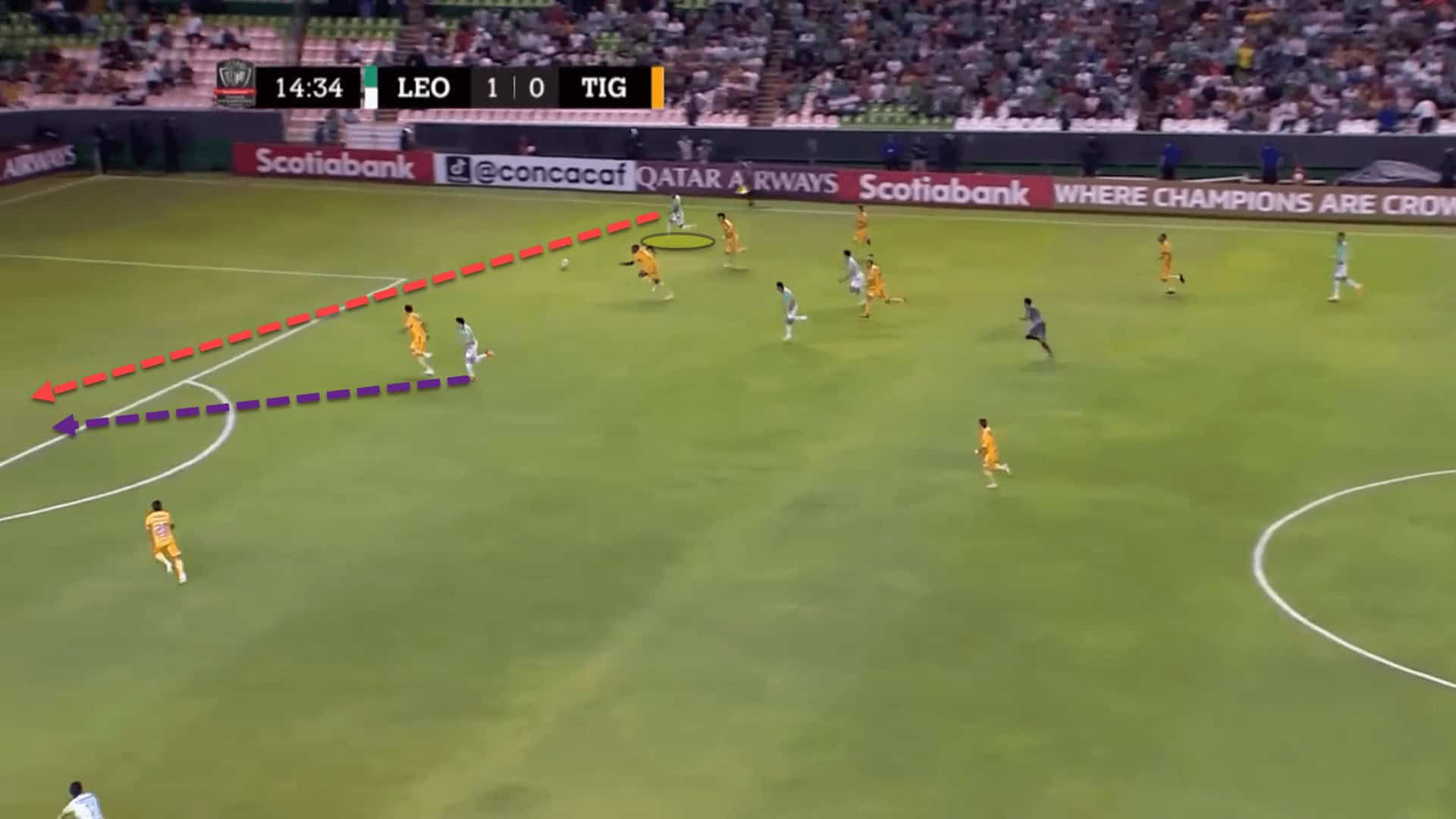
The idea is to get one man free into a crossing position to deliver a ball into the box. In the previous image, León managed to slip in the right-back Byron Castillo who made a dangerous third-man run in behind the Tigres backline.
The fullback eventually crossed it into the centre-forward who somehow failed to convert the opportunity, but the rebound was poked home by the right winger Ángel Mena, giving his side the lead in the tie.
Things look slightly different if the ball is switched out to the left flank.
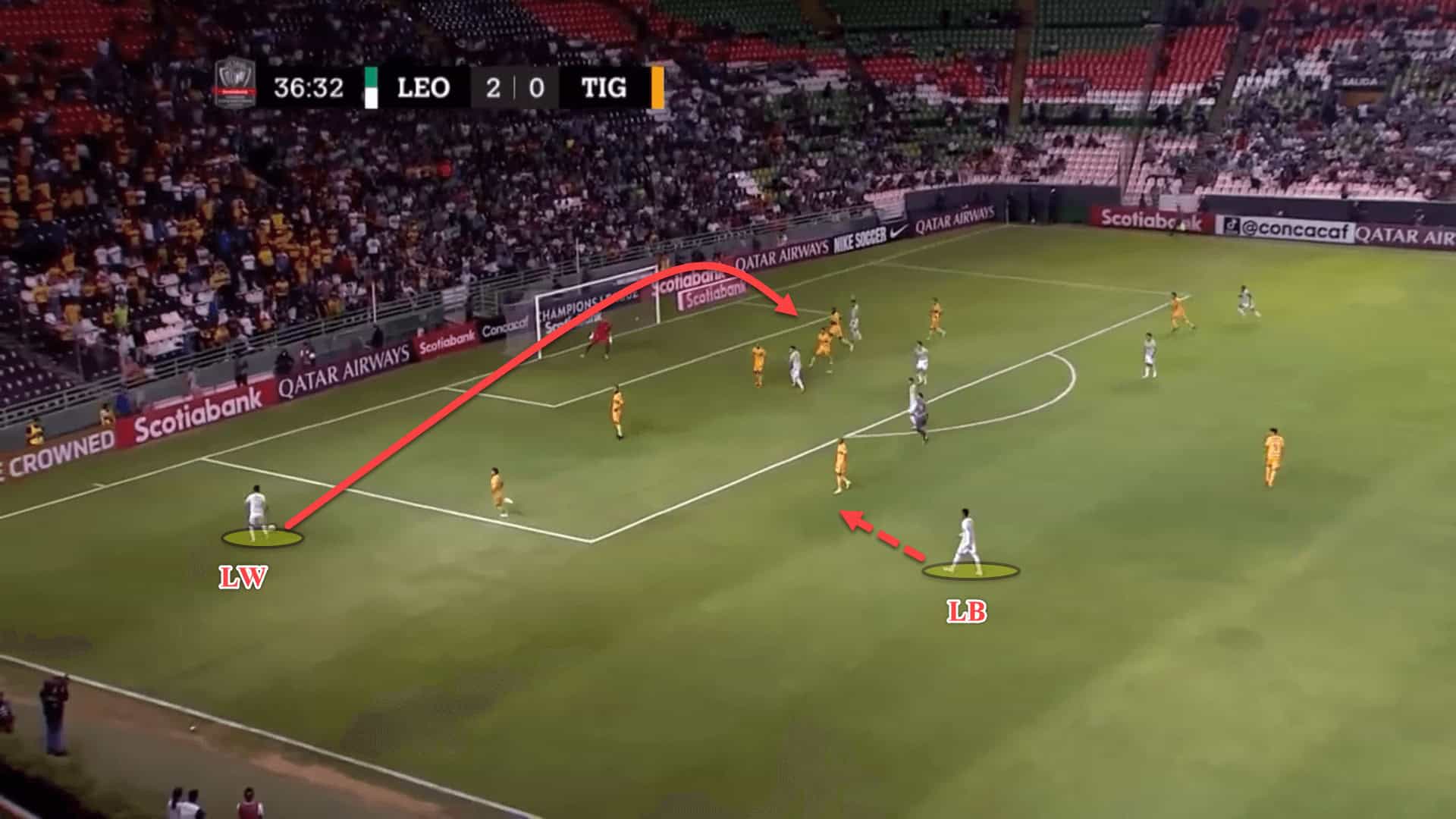
When this happens, the left winger is the man holding the width, looking to drive at the opposition’s fullback. However, he is supported by the left-back who positions himself in the halfspace.
There are two reasons for this. Firstly, the fullback can play a halfspace cross if the winger cuts the ball back to him in time and space. Secondly, the fullback is positioned there to help León win the ball as high up the pitch as possible in case of a turnover of possession.
Los Panzas Verdes average 15.98 crosses per game this season under Larcamón, with a decent accuracy of 35.2 percent. But unfortunately, it is their main source of chance creation.
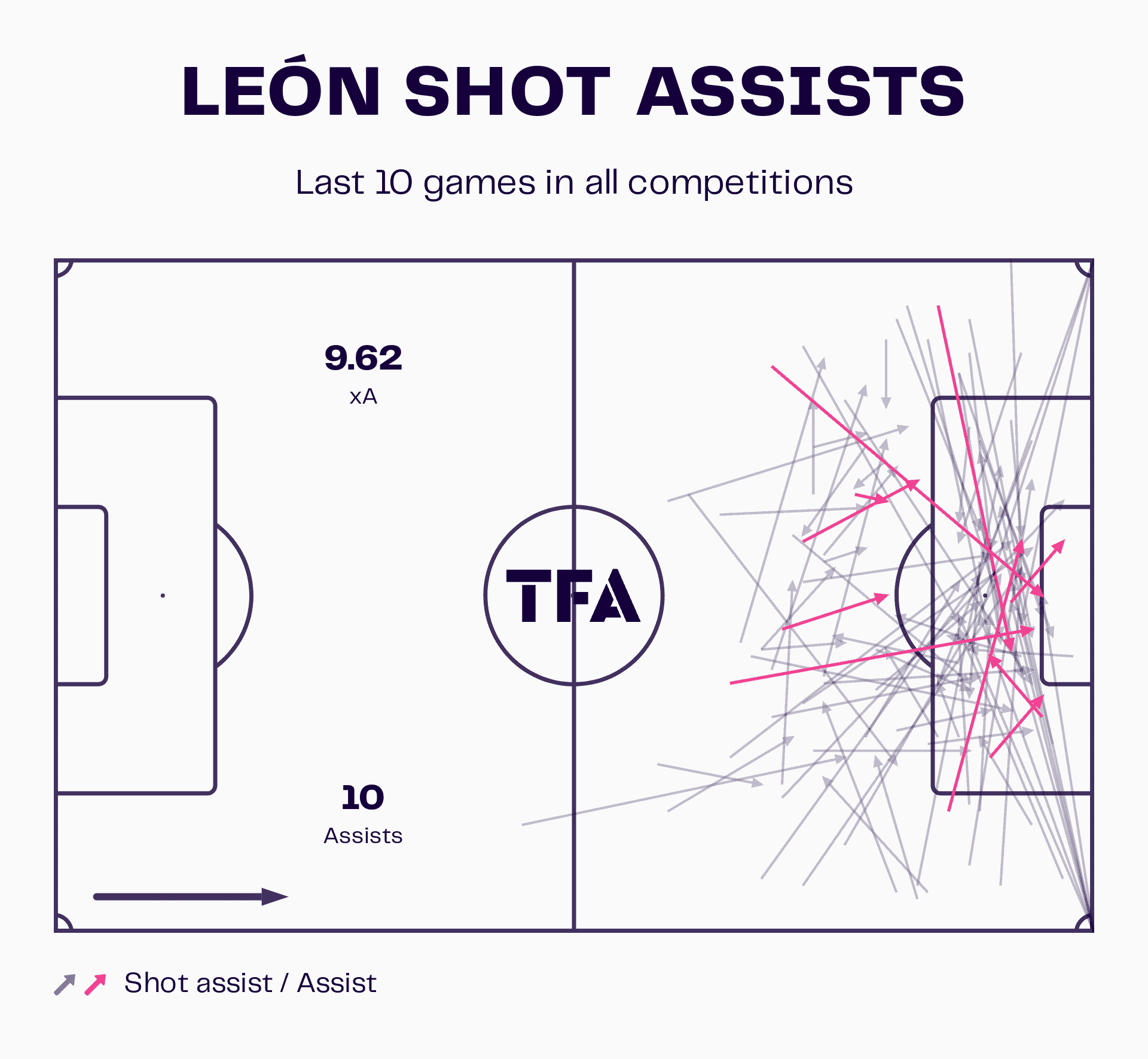
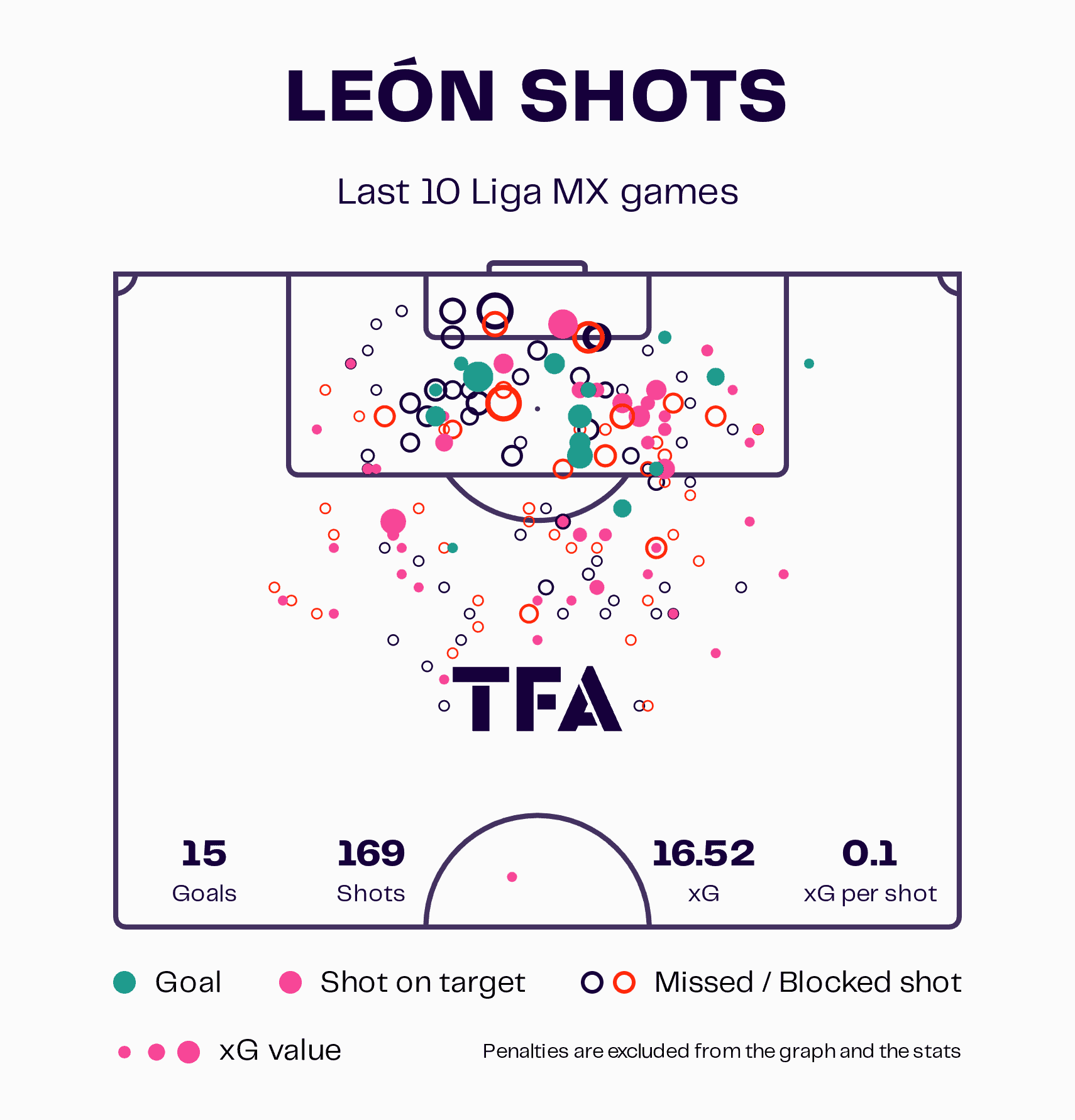
León are a fascinating example of a team that are performing quite well in terms of expected assists and expected goals in comparison to reality. So, there’s no real issue of underperformance in front of goal, even though they are scoring fewer than the majority of Liga MX.
The problem then could lie simply in the fact that they are not getting the ball forward enough. Considering they are quite effective when going forward, perhaps they would perform the same if the forwards were fed more chances.
The best defence in Mexico
As aforementioned, León finished the Clausura campaign with just 13 goals conceded, holding the best defence in Liga MX in 2023 until the playoffs.
Larcamón’s defensive tactics have been a massive factor behind the team reaching the CCL final for the first time in 30 years too. The defensive system is expandable and not that compact but leaves León in a position to defend duels all over the pitch.
The first thing to note is the formation and the average height of the block.
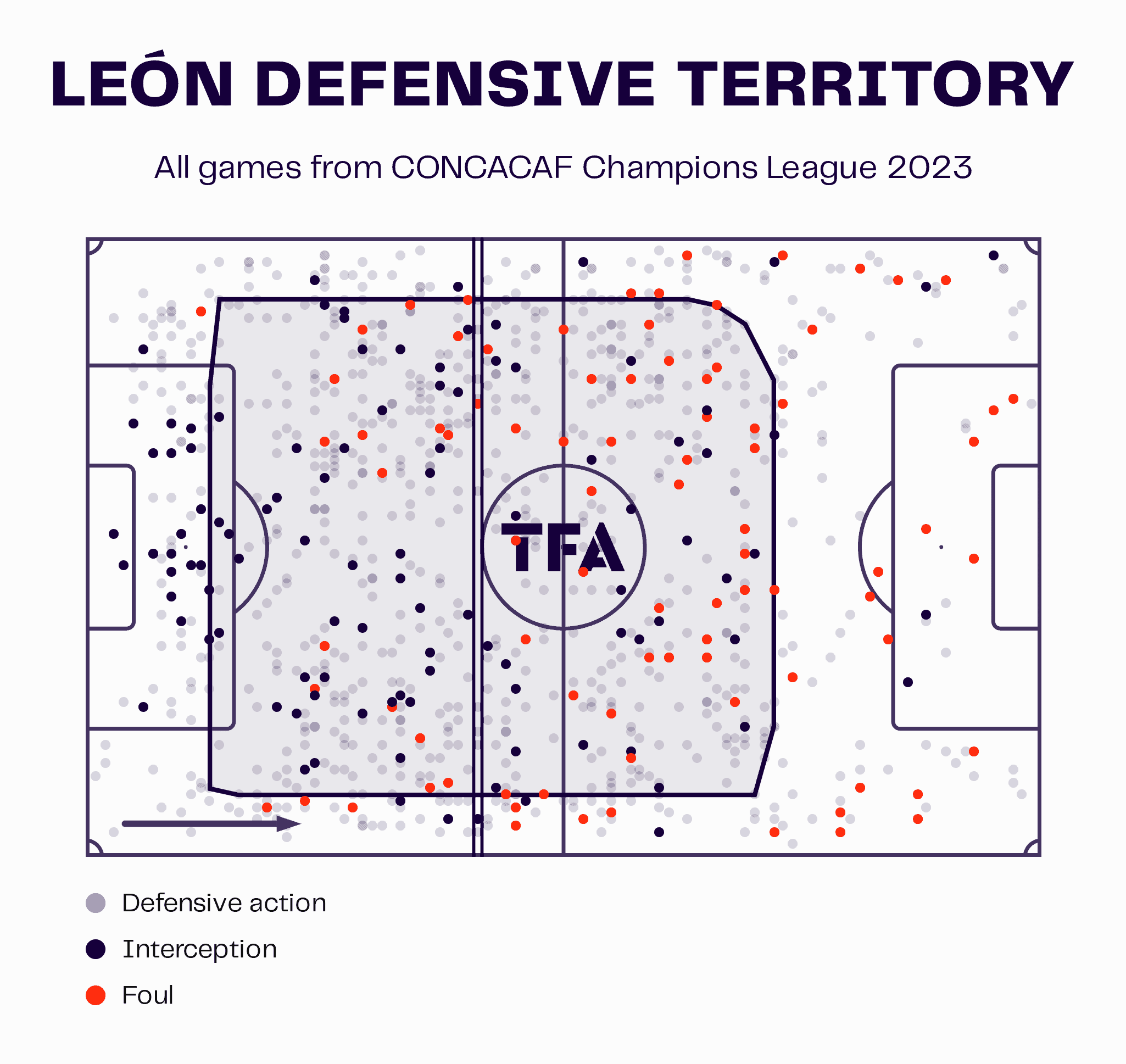
León look to defend as much as possible in a mid-block, although this can easily become a mid-to-high block or mid-to-low block depending on where the ball is. But for the most part, León try to cut off access to the middle third of the pitch.
The frontline don’t really press that high. Instead, since Larcamón deploys a 4-2-3-1, the number ‘10’ pushes up alongside the centre-forward to create a first line of pressure to block the passing lane into the opposition’s pivot player or deepest midfielder.
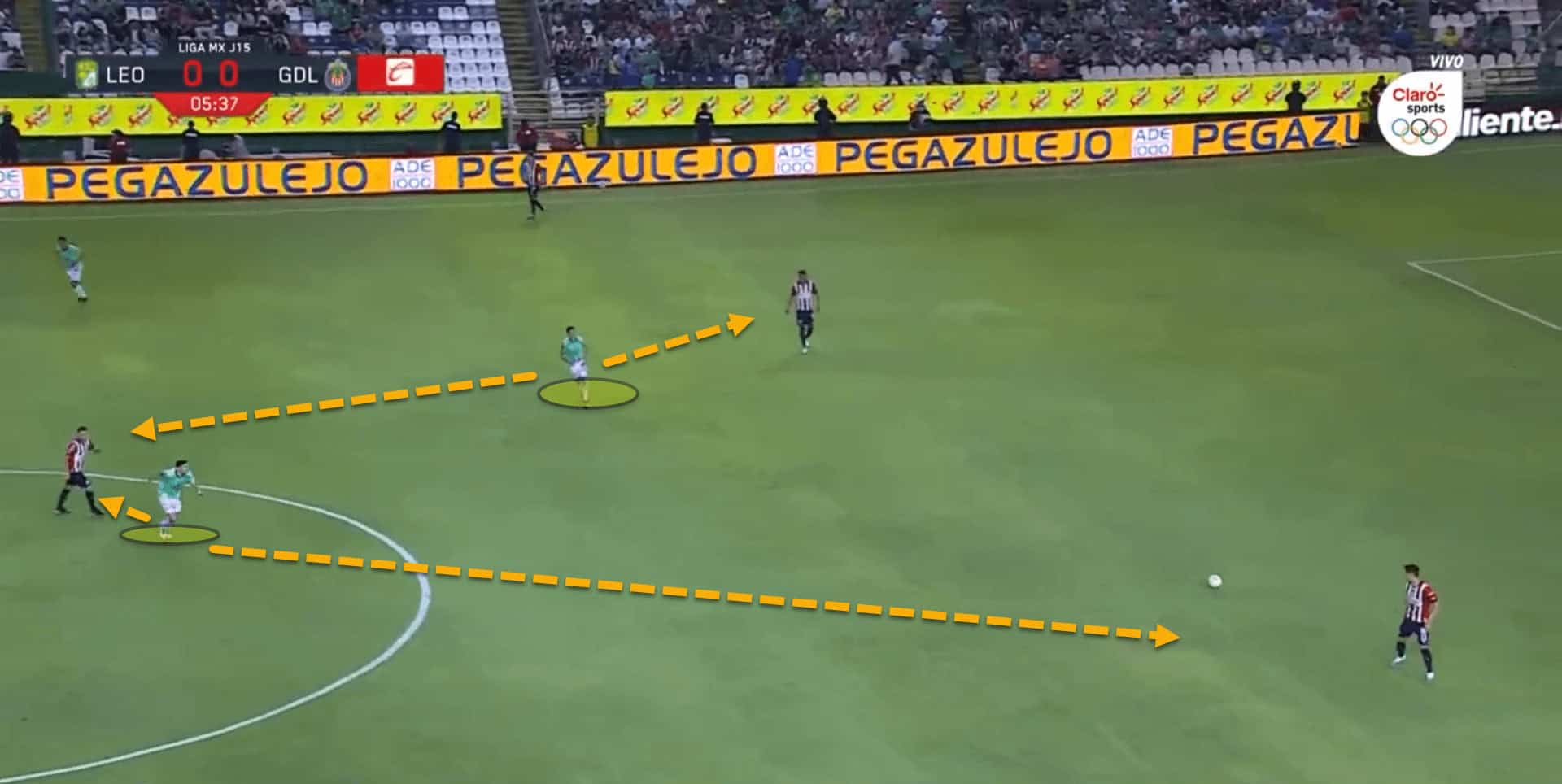
When one of the front two press the ball-carrying centre-back, the other drops off onto the pivot, ensuring that there is always someone sitting on the attacking side’s number ‘6’.
The positioning of the rest of the players is dictated by the positioning of the opposition. Some coaches prefer their teams to defend in a deep, zonal block, compacting space between the lines and shifting as a unit from side to side whenever the ball moves. The 38-year-old coach doesn’t necessarily subscribe to this tactical viewpoint.
León are not that compact horizontally or vertically when defending in a block.
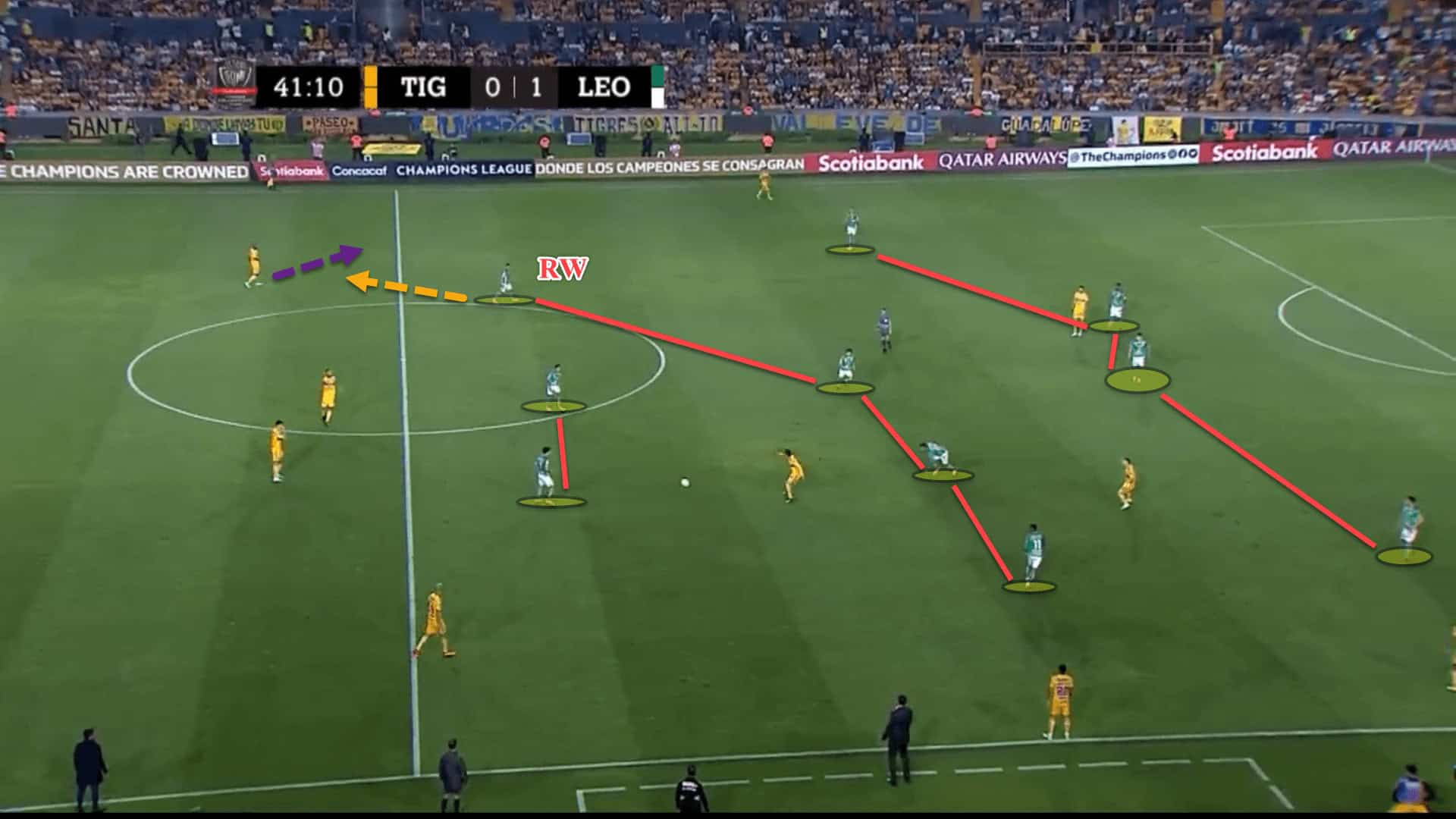
We can make out that the shape is a 4-4-2 mid-to-low block but the structure is dictated by the opposition more than space.
Look at León’s right winger for instance. He is staying slightly higher as the opposition’s left-back has not advanced forward. Now, what happens when the opponent’s fullback does venture up to the last line?
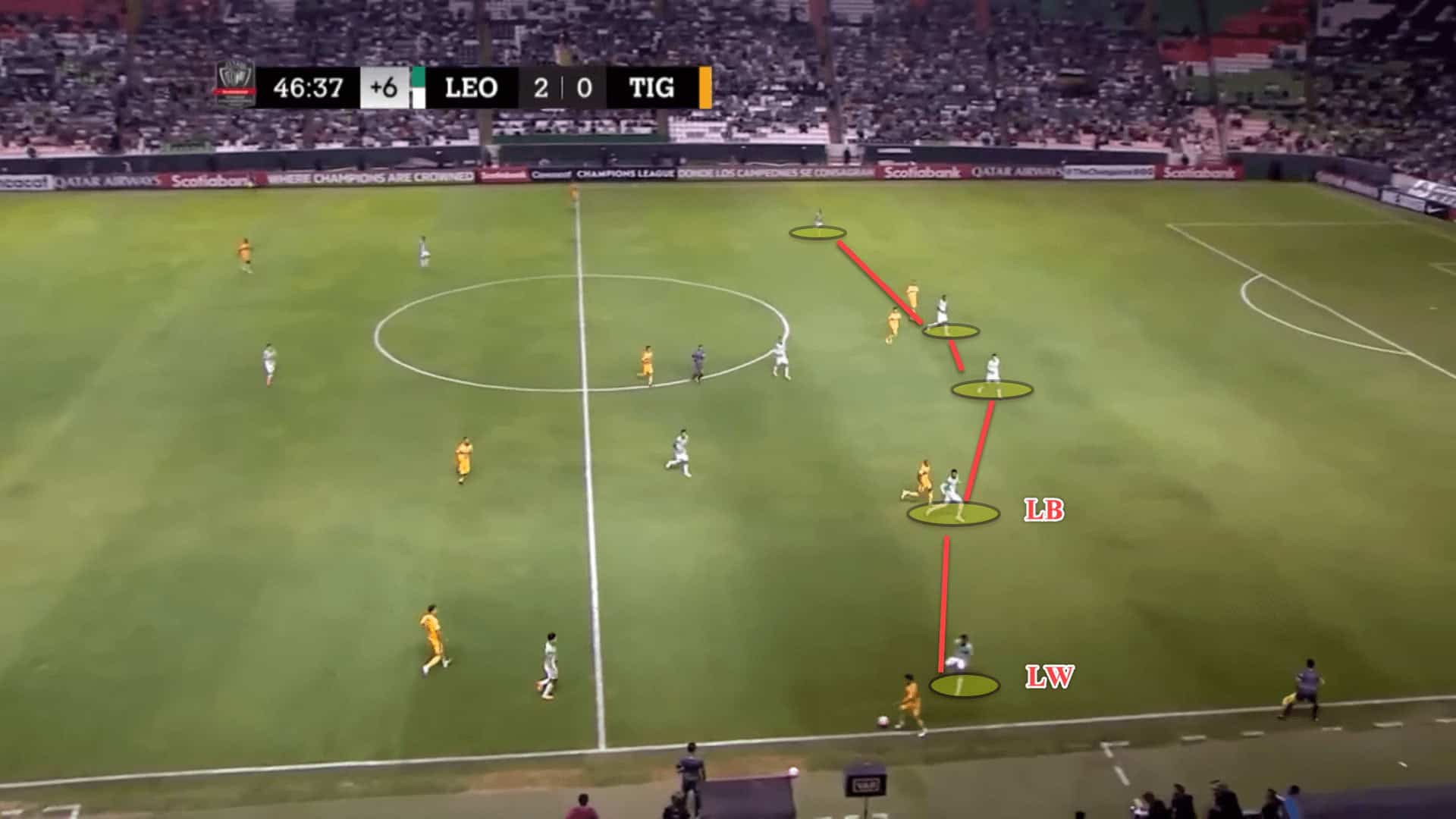
Here, Tigres’ right-back has advanced forward and so León’s left winger has tracked back on the same flank. Meanwhile, León’s left-back is sticking very tightly to the opposition’s right winger. The shape resembles that of a 5-4-1 but there’s no point in being pedantic. The formation is a 4-4-2 which bends to the will of the opposition rather than allowing itself to be broken.
Their defensive system is heavily duel-based and mixes both a zonal and man-marking approach very well. Once León win most of their duels, then the team defends well. This season, the Mexican side have boasted a 61.6 percent duel success rate. However, there are times when teams can exploit the deficiencies of this type of scheme.
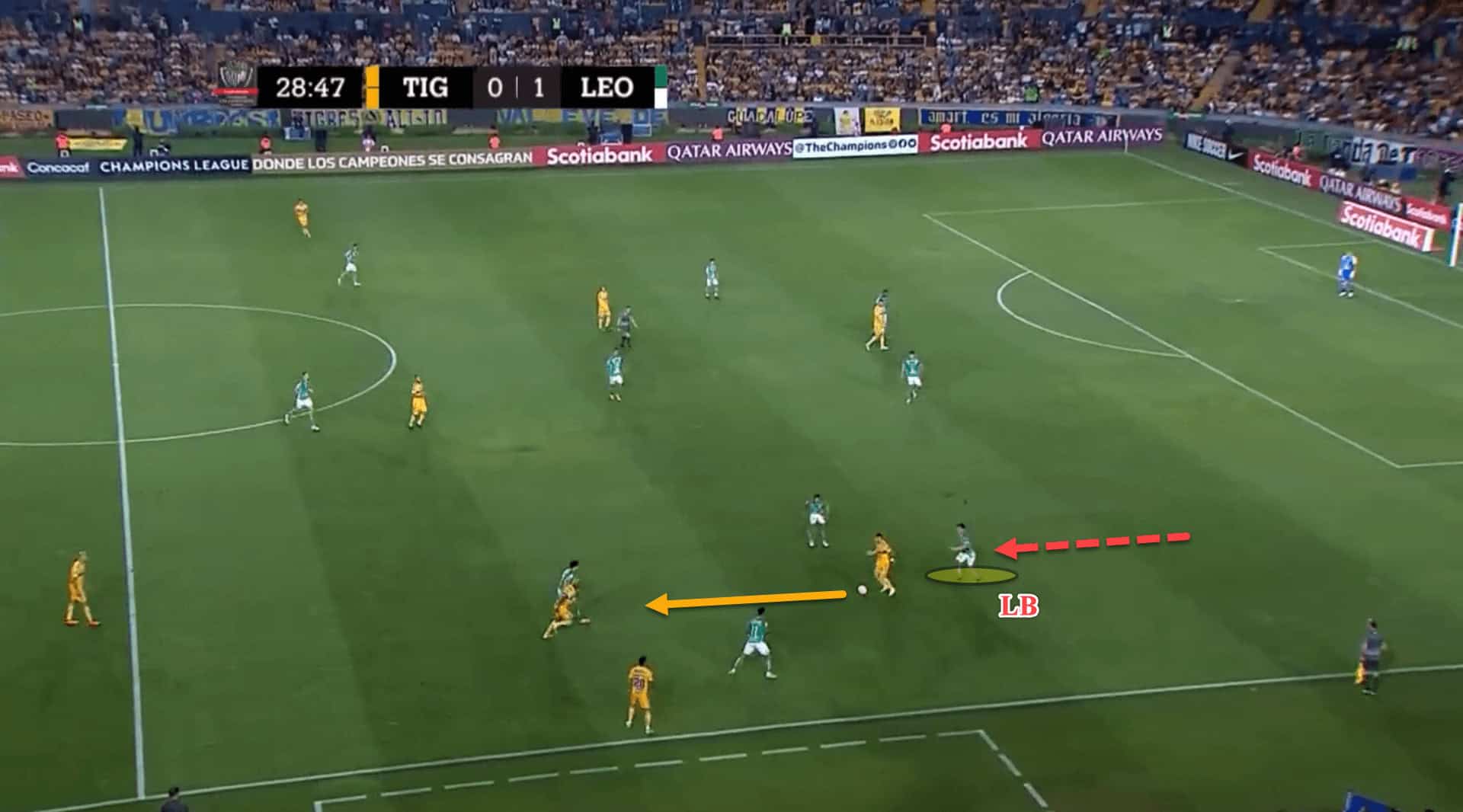
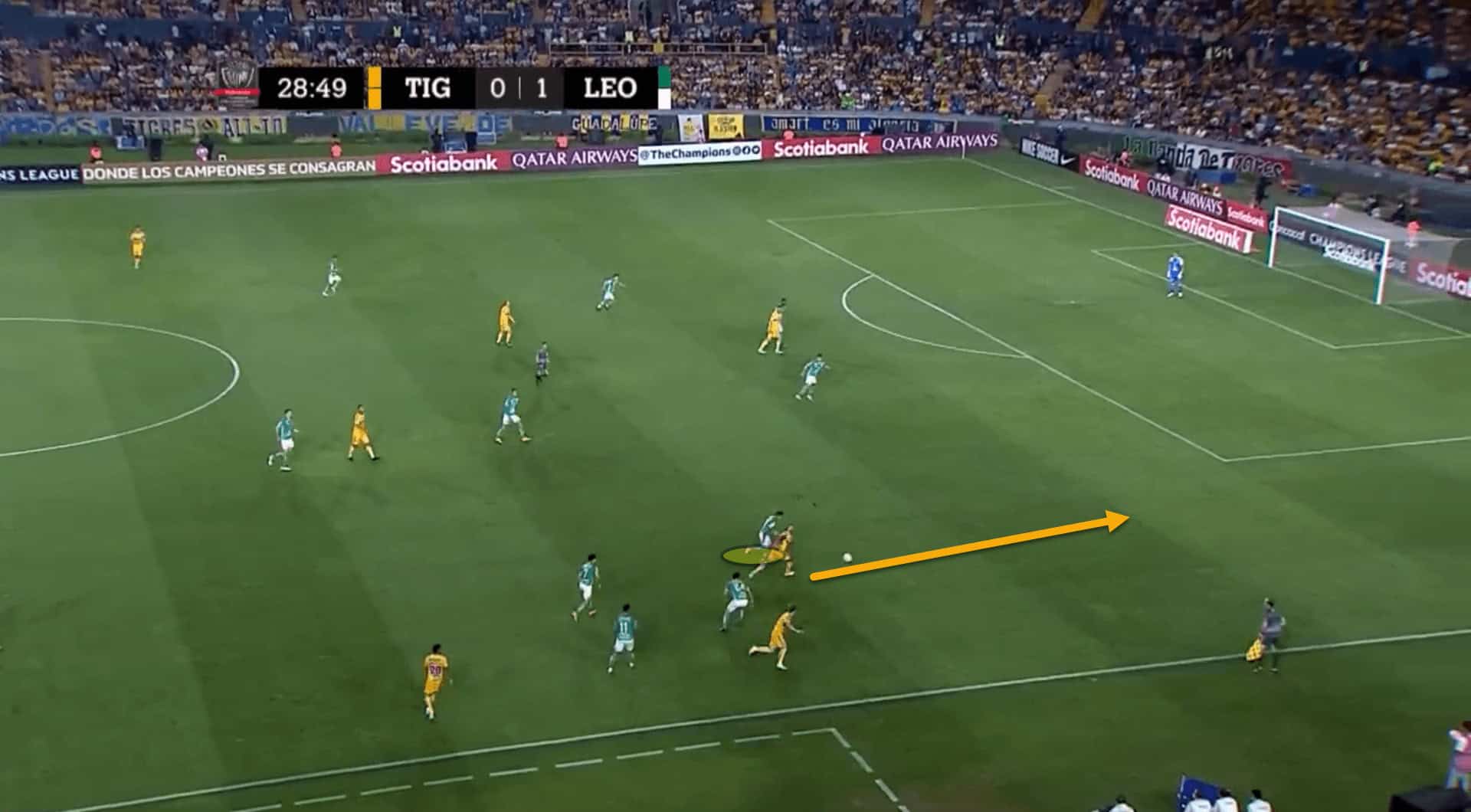
León’s left-back has been attracted to his man in a deeper area. The Tigres player lays it off to his teammate making a run in behind him which works well for the hosts as the winger latches onto the pass and drives into the space behind León’s backline, preparing for a cross into the penalty area.
Nonetheless, every defensive system has its weaknesses. The fact that León have reached the final of the CCL and held the best defensive record in the Clausura this season showcases the effectiveness of Larcamón’s tactics out of possession.
Conclusion
Under the guidance of an exceptional, young coach, León are on the cusp of achieving a historic feat for the club.
The 38-year-old’s tactics are not always exciting or exhilarating, but Larcamón has managed to get a tune out of the players at his disposal and play to their strengths, as this team scout report has shown.
León’s tactics may not be as easy on the eye as most in Liga MX or on the continent for that matter but may be enough to see Los Panzas Verdes lift the CONCACAF Champions League crown for the first time ever.






Comments